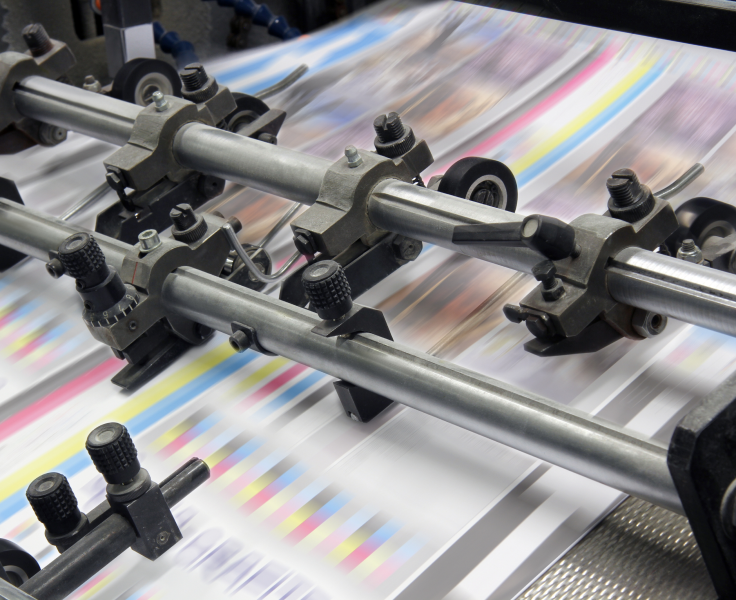Managed Print Service vs Outsourcing: Your Guide to Choosing the Most Cost-Effective and Flexible Communications
Managed print service and outsourcing: two options, two vastly different solutions. So, which one adds to your bottom line without sacrificing operations?
In today’s economy, organizations in highly regulated industries face urgent questions: How can we lower our print and mailing costs? And how do our current workflows impact our day-to-day efficiency?
With the right managed print service (MPS) provider, it’s possible to reduce waste and enhance document security for incredibly efficient, streamlined print production.
However, it might also be time to take your operations to the next level. Print and mail outsourcing can benefit companies by helping them to realize greater operational agility and cost savings.
But the question remains: Which is the right option for your organization?
Keep reading! This guide explains the differences between managed print service and outsourcing to help you choose the most cost-effective and flexible communications for your business.
What’s Inside:

What are Managed Print Services (MPS)?
Managed print service (MPS) is the term used to describe the services offered by a third-party provider who manages and optimizes an organization’s physical document output.
An MPS is responsible for maintaining a physical presence at a customer location to provide on-site print operations. The provider then becomes responsible for an organization’s overarching print infrastructure and ensures that all printing devices align with business needs to reduce costs and improve operational efficiencies.

What is Print and Mail Outsourcing?
A third-party provider offers print and mail outsourcing services and solutions. They manage and are responsible for printing, mailing, and document distribution on behalf of an organization.
Organizations that handle large volumes of mail like customer communications, compliance documents, marketing materials, invoices, statements, and bills should strongly consider print and mail outsourcing for reduced costs, increased efficiency, and to ensure compliance with mailing regulations.

What are the Key Differences Between Outsourcing Print and Mail and a Managed Print Service?
1. Services Offered:
Managed print services oversee internal print environments (in-house). Print and mail outsourcing provides print production and mail operations and services (external).
Managed Print Service:
- Focuses on an organization’s print infrastructure and how to best optimize related processes.
- Services include document workflow automation, supply replacement, device maintenance, and printer management.
- Capable of handling internal documents, such as reports, presentations, and forms.
- Communications are shared internally, either in print or digitally.
Outsourcing:
- Operates by contracting out all the organization’s print and mail services.
- Services include printing at high volumes, folding, inserting, mailing, address validation, and compliance.
- Handles large print jobs of crucial communication pieces for external customers, such as statements, marketing materials, regulated communications and more.
- Communications are printed, prepped, and mailed to the correct recipient.
2. Cost Considerations:
Managed print services help reduce operational expenses around internal printing. Print and mail outsourcing removes management pressure around operations and offers cost advantages for bulk print jobs.Managed Print Service:
- Investment is required to update or get new software and any integrations.
- Optimizing in-house printing operations reduces related long-term expenses.
- Lowers costs linked to waste and energy.
Outsourcing:
- Zero investment upfront, services are billed monthly, or per job.
- Removes any in-house printing costs related to maintenance, consumables or labor.
- Discounts on bulk postage and reduced labor.
3. Operational Flexibility:
Managed printed service providers offer direct control, in-house over daily printing activities. Outsourcing your print and mail means the provider will take care of all printing and mailing for external recipients.Managed Print Service:
- Optimize the print environment and allow organizations to maintain autonomy over their day-to-day printing.
- Maintains the in-house printing infrastructure with enhanced efficiency.
- Production time is short, and you can access printed documents instantly.
- Requires additional investment to scale and grow.
Outsourcing:
- A print and mail outsourcing provider will manage all print and mail processes externally.
- It follows a standard process, however there is room for personalized mailings.
- A production schedule is set by the provider based on your requirements, order volume, complexity, and mailing deadlines.
- Incredibly flexible, it’s easy for the provider to increase or adjust your print and mail volumes.
4. Security and Compliance:
Managed print services aim to keep the internal print infrastructure secure. Outsourcing must offer and provide secure, compliant mail handling to handle industry specific regulatory requirements.Managed Print Service:
- Ensures communications adhere to data regulation protections, including HIPAA, GDPR, etc.
- Manages printing devices and workflows with user authentication, data encryption, and more, to keep data secure and meet compliance requirements.
- Provider will monitor the access log and print usage.
Outsourcing:
- Serves to provide compliant print and mail communications that fall in line with regulatory requirements, such as HIPPA, GDPR, and the IRS.
- Must trust the third-party organization with sensitive data, however, appropriate security measures are available.
- The third-party organization provides tracking and auditing for proof of delivery.
5. Integration Capabilities:
Managed print service can integrate with internal workflows, potentially at a cost. Outsourcing print and mail can integrate with other crucial platforms, like customer communication management (CCM) solutions.
Managed Print Service:
- Integrates with internal systems, including document management systems (DMS) and cloud storage.
- Can help with internal digital transformation efforts for digital communications storage.
- Provides automation features like automated supply replenishment, cost tracking, and print rules.
Outsourcing:
- Easily integrates with platforms like CCM, customer relationship management (CRM), and other systems.
- Offers automation features, including variable data printing, address validation, and automated mailing schedules.
- Gives options for print and digital delivery to support hybrid print and mail for seamless omnichannel communication.
Want to learn more about the power of outsourcing print and mail? Contact us today!
3 Benefits of Managed Print Service
Managed print service offers organizations many benefits, including:
1. Lowered Printing Costs
Managed print service providers can help reduceing unnecessary print jobs.
With secure print release, it’s possible to require print authentication before a print job is run. Providers can also implement automated print rules that encourage more efficient printing, like sending large jobs to the most cost-effective printers. Less waste results in reduced product and material usage, for lowered printing costs.
Consolidating printing equipment is another cost-saving area. Unconsolidated devices can lead to high maintenance costs and fragmented print environments.
2. Enhanced Productivity and Efficiency
Managed print services help reduce downtime because they provide automated technologies that streamline print performance.
For example, a managed print service provider can identify and fix issues remotely, often before they arise. An MPS can also trigger automatic updates to security and software, and route print jobs to the most efficient printer.
Automation reduces the need for manual intervention while ensuring print production runs smoothly across the organization.
3. A Reliable Option for Secure, Internal Communications
Sensitive data, like customer information or regulatory compliance documents, must be protected from vulnerabilities like cyberattacks. Unsecured printers can become a huge liability, especially in highly regulated industries.
Managed print services can support secure print releases, with a PIN or biometric authentication to reduce the risk of unauthorized access to sensitive data. Data encryption assists MPS providers in keeping communications secure with protocols, such as TLS (Transport Layer Security) and SSL (Secure Sockets Layer). Cloud-based monitoring for real-time insights into potential breaches or unauthorized access is also a service MPS provider’s offer to protect data sent via the cloud or mobile devices.
3 Benefits of Outsourcing Print and Mail
1. Reduced Operational Costs
2. Improves Operational Flexibility
3. Secure and Compliant Delivery of Customer Communications
Choosing Between Managed Print Service and Outsourcing
Option 1:
An organization desires to lower printing costs, manage day-to-day print workflows, enhance office printer use, and securely print internal communications or documents with a service that maintains a physical presence to provide on-site print operations.
The business needs a managed print service.
Option 2:
The business needs to print and mail large volumes of communications, wants to outsource those communications to eliminate the need for in-house printing, and improve the cost, efficiency, and effectiveness of the print and mail process.
The organization needs print and mail outsourcing.
Option 3:
The company currently uses in-house print operations and already works with a managed print service provider. However, the business must now print large volumes of communication that the in-house operations can’t handle without expensive upgrades.
The business should consider investing in a move from MPS to Outsourcing. It’s a great next step in expanding the delivery channels of documents and communications to fully realize greater cost savings and flexibility.
How to Choose the Right Service Provider
1. CCM Builds Deeper Customer Relationships
Searching for the right managed print service or outsourcing provider is well worth the effort. But it can sometimes be a challenge to start!
For a partnership with a managed print services or outsourcing provider that lasts, check out the following best practices:
- Dig into the provider’s service level agreement (SLA): can they efficiently and successfully offer service to all your locations? What are their response times, and how do they resolve service or production issues?
- Ask about print spend visibility: The right provider will offer print spend visibility and help you understand your estimated costs and ways to save.
- Look for a one-stop shop: The ideal provider should offer everything you need to suit your business needs.
- Security, security, security: Find out which tools and technologies the provider uses to monitor and check for vulnerabilities.
Are Managed Print Services or Outsourcing Worth It?


